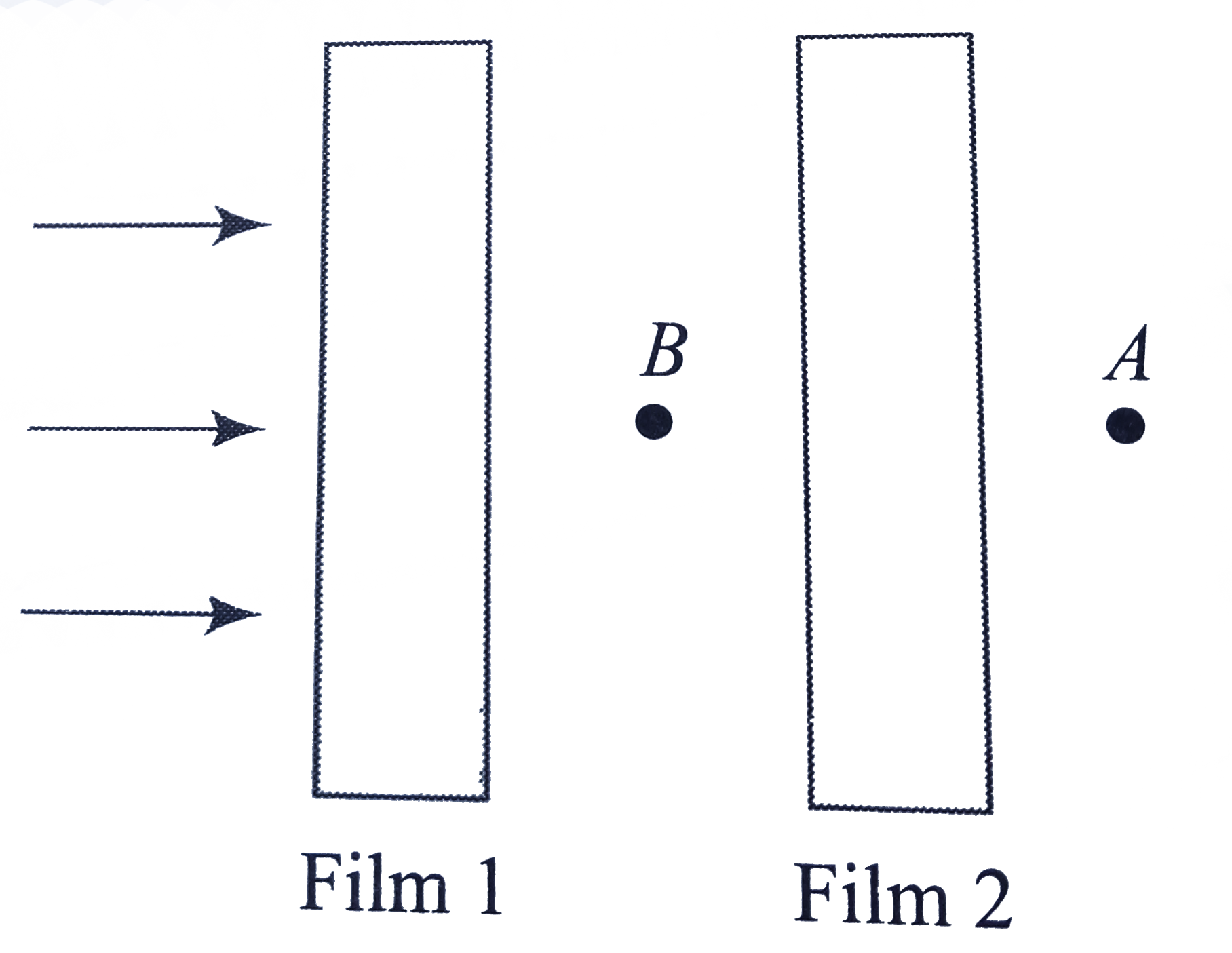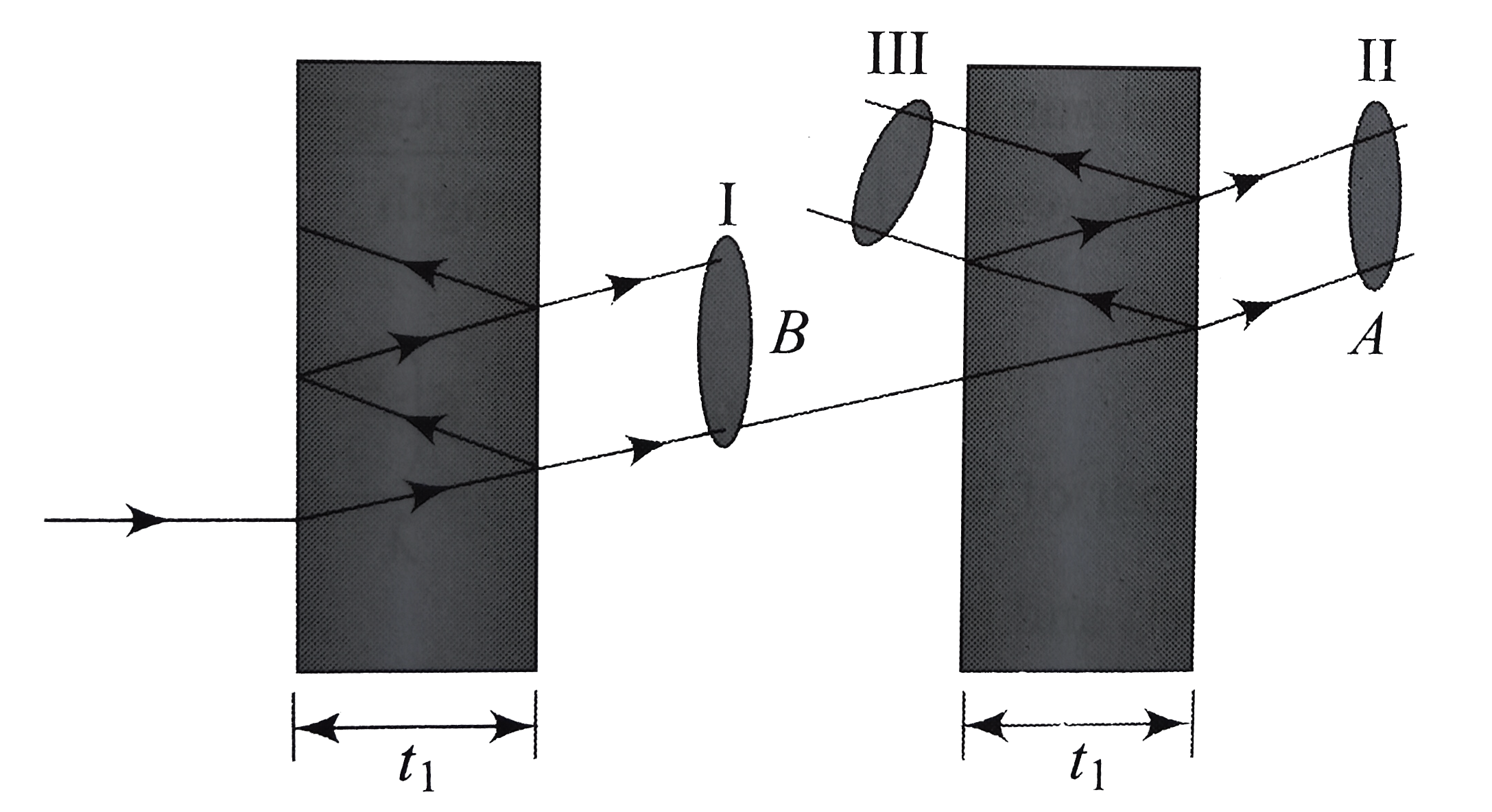Two thin films of the same material but different thickness are separated by air. Monochormatic light is incident on the first film. When viewed normally form point A, the second film appears dark.

the first film will appear bright
the first film will appear dark
the second film will appear bright
the second film will appear dark
The correct Answer is:d
Path difference between waves of
I is →2μt1
II is →2μt2
III is →2μt3
System I is used to observe film 1 and A, system II is used to observe film 2 form B, and system III is is used to observe film 2 from A. It is given that 2μt2= odd multiple of λ/2, i.e., dark. So, from A film 2 appears dark while for I, relation between t1 and t2 has to be known.

Topper's Solved these Questions
- WAVE OPTICSBOOK - CENGAGE PHYSICSCHAPTER - WAVE OPTICSEXERCISE - Multiple Correct
8 Videos
- WAVE OPTICSBOOK - CENGAGE PHYSICSCHAPTER - WAVE OPTICSEXERCISE - Assertion- Reasoning
13 Videos
- WAVE OPTICSBOOK - CENGAGE PHYSICSCHAPTER - WAVE OPTICSEXERCISE - Subjective
11 Videos
- THERMODYNAMICSBOOK - CENGAGE PHYSICSCHAPTER - THERMODYNAMICSEXERCISE - QUESTION BANK
34 Videos
- WAVESBOOK - CENGAGE PHYSICSCHAPTER - WAVESEXERCISE - QUESTION BANK
38 Videos
Similar Questions
An oil film covers the surface of a small pond. The refractive index of the oil is greater than that of water. At one point on the film, the film has the smallest non-zero thickness for which there will be destructive interference in the reflected light when infrared radiation with wavelength 800 nm is incident normal to the film. When this film is viewed at normal incidence at this same point, for what visible wavelengths, if any, will there be constructive interference? (Visible light has wavelengths between 400nm and 700 nm )
View SolutionAn oil film covers the surface of a small pond. The refractive index of the oil is greater than that of water. At one point on the film, the film has the smallest non-zero thickness for which there will be destructive interference in the reflected light when infrared radiation with wavelength 800 nm is incident normal to the film. When this film is viewed at normal incidence at this same point, for what visible wavelengths, if any, will there be constructive interference? (Visible light has wavelengths between 400nm and 700 nm )
View Solution
Knowledge Check
A soap film of thickness is surrounded by air. It is illuminated at near normal incidence by monochromatic light which has wavelength λ in the film. What will be the film thickness that will produce maximum brightness of the reflected light?
A(1/4)λB(1/2)λCλD2λWhen a thin film of thickness t is placed in the path of light wave emerging out of the slit , then increase in the length of optical path will be
A(μ−1)tB(μ+1)tCμtDμtA thin film of a specific meterial can be used to decrease the intensity of reflected light. There is destrucive inteference of wave reflected from upper and lower surface of the film. These films are called non-reflecting or anti-reflecting coatings. The process of coating the lens or surface with non-reflecting film is called blooming as shown in figure The refracting index of coating (n1) is less than that of the glass (n2).

6. If the thickness of film in above question in not technologically possible to manufacture, then next thickness of film required is (approximately)A298.9 nm .B271.7 nmC304.7 nm .D550 nm, .’
A soap film of thickness t is surrounded by air and is illuminated at near normal incidence by monochromatic light wavelength λ in the film. With respect to the wavelength of the monochromatic light in the film, what film thickness will produce maximum constructive interference
View SolutionA thin oil film of refractive index 1.2 floats on the surface of water (μ=43). When a light of wavelength λ=9.6×10−7m falls normally on the film from air, then it appears dark when seen normally. The minimum change in its thickness for which it will appear bright in normally reflected light by the same light is:
View SolutionA thin film (n = 1.25) coats a thick glass plate (n = 1.50). White light is incident normal to the film. In the reflections, fully destructive interference nccurs at 600 mm and fully constructive interference at 700 nm. Calculate the thickness of the film.
View SolutionA very thin transparent film of soap solution (thickness→ 0) is seen under reflection of white light. Then the colour of the film appear to be :
View SolutionLight of wavelength 6000Å is reflected at nearly normal incidence from a soap films of refractive index 1.4 The least thickness of the fringe then will appear black is
View Solution
